California Alliance improving pipeline to the professoriate
A conference at Berkeley this week will showcase the promising results of efforts funded by the National Science Foundation

March 13, 2018
At age seven, Amal El-Ghazaly disassembled her headphones to see why they broke. Noticing this, her dad, an engineer, began teaching her about electronics.
In high school, as the only girl competing for top exam scores in math and science, she regularly beat the boys. “It didn’t matter whether they accepted me as one of their own,” she says. “I’m a very competitive person.”
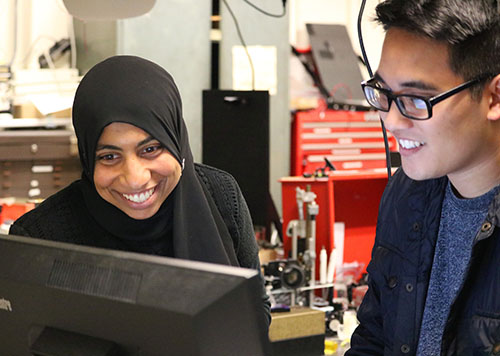
Amal El-Ghazaly supervises undergraduate Brandon Tran in their laser lab in Cory Hall. She says she wants to be on a faculty someday because professors “have an incredible impact on students’ lives.” (UC Berkeley photo by Kirpa Singh)
But in college, where colleagues and mentors are a key to success, El-Ghazaly was often alone. A hijab-wearing Muslim of African heritage, she was usually the only underrepresented minority student, and sometimes the only woman, in her courses in applied physics, her specialization within electrical engineering, at the two top-tier schools she attended.
As an aspiring professor, she wondered — since all her applied physics instructors were men, and just one was from an underrepresented minority — if she’d ever find a department to work in with an inclusive and supportive climate.

“I trust myself to lead my own projects,” says Amal El-Ghazaly. “I know what’s best for my own work, and I’m just going to do it.” (UC Berkeley photo by Kirpa Singh)
“I’ve been an island, on my own. That’s been the hardest part,” says El-Ghazaly, who relied on calls home to family in Tennessee and books about diversity in academia for support.
Today, El-Ghazaly — despite being one of two underrepresented minority scholars, and the only woman, in Berkeley’s Nanoelectrics and Nanostructures Group — is no longer so isolated. She’s among 25 scholars from Berkeley, Stanford, Caltech and UCLA who have postdoctoral fellowships in the California Alliance for Graduate Education and the Professoriate, a diverse, cross-institutional community of Ph.D. students, postdoc scholars and faculty members funded by the National Science Foundation (NSF).

William Tarpeh, a former graduate student at Berkeley in civil and environmental engineering, is now a postdoc at the University of Michigan. He’ll speak at this week’s California Alliance retreat about applying for postdoc positions. (California Alliance photo)
The four elite schools joined forces in 2014 to address a nationwide crisis: seemingly intractable ethnic underrepresentation in key STEM fields — mathematical, physical and computer sciences and in engineering — in the postdoctoral and faculty ranks at prestigious universities.
Fewer than 2,000, or about 4 percent, of the nation’s 46,000 postdocs in science and engineering are underrepresented minorities, according to the most recent data from the National Science Foundation (NSF).
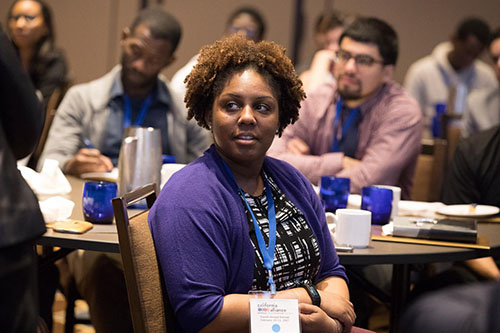
Makita Phillips, a former UCLA postdoc, will participate in the Alliance retreat at Berkeley later this week. (Reed Hutchinson PhotoGraphics)
Four years after the launch of the Alliance, which provides underrepresented minority scholars with faculty mentoring, professional development and academic networking opportunities, those leading the effort say they’ve begun turning those numbers around. The NSF has also given the Alliance a second grant to expand its reach to peer institutions nationwide.
“We had a vision that, through collaboration at the highest levels, these four peer institutions would be able to move the needle, and we’ve demonstrated that,” says Mark Richards, professor of earth and planetary science at Berkeley and the Alliance’s leader. “We’ve succeeded through a combination of genuine commitment and resources.”
The Berkeley-led Alliance will share its challenges and successes this week on campus when it hosts Pathways to a Diverse Professoriate, a national conference. On Thursday and Friday, March 15 and 16, leaders and researchers from programs funded by the NSF to diversify the professoriate will present their research aimed at increasing STEM diversity at the graduate level and beyond.
Gold mine of applicants
One of the Alliance’s greatest successes has been proving wrong those in higher education who say there are no exceptionally qualified underrepresented minority candidates to hire into open faculty positions in these STEM fields.

Colette Patt, Alliance director, with psychology professor and Alliance research director Rodolfo Mendoza-Denton (center) and professor of earth and planetary science and Alliance leader Mark Richards. (UC Berkeley photo by Hulda Nelson)
In 2013, the NSF gave the Alliance enough funding for four postdoc fellows, but “we believed we could find many more than that, and we received about 50 applications from all over the country. We were ecstatic,” says Alliance director Colette Patt, who also is assistant dean of Berkeley’s Mathematical and Physical Sciences Division. Each year since, at least 50 applications arrive.
By leveraging funds and partnering with many sources, the Alliance schools have collectively provided fellowships to 32 postdoctoral researchers — eight times the number funded by the NSF — during the past four years.
With underrepresented minority postdocs in the mathematical, computer, chemical and physical sciences and in engineering at Berkeley, Stanford, Caltech and UCLA representing about 6 percent of the schools’ combined postdoc population — 58 of 1,050 postdocs — in 2011, according to California Alliance data, the Alliance’s recruitment of 32 postdoc fellows is “significant,” says Patt.

“By working together,” says Alliance leader Mark Richards, “these four prestigious institutions are able to go where they couldn’t go on their own.” (UC Berkeley photo by Hulda Nelson)
Of the 25 current fellows, four are at UCLA, six at Stanford, seven at Berkeley and 15 at Caltech. Of the seven who finished the program, one is an astronaut, four have faculty positions — at UC Santa Cruz, UC San Diego, Rice University and San Francisco State University — and two took jobs in industry.
“No one can tell any of these (STEM) departments any more that we can’t find qualified minority applicants,” agrees Richards. “We have; they’re there.”
“And with opportunity to excel,” adds Patt, “they will join the professoriate.”

In 2016, then-Stanford Ph.D. student Amal El-Ghazaly met Jeffrey Bokor, professor of electrical engineering and computer science, at a California Alliance retreat. She now is part of Bokor’s Nanoelectrics and Nanostructures Group. (California Alliance photo by Ken Light)
El-Ghazaly got her chance to excel as a Stanford Ph.D. student attending a California Alliance retreat. There, she met Jeffrey Bokor, a Berkeley professor of electrical engineering and computer science who was speaking on a panel.
“I wanted to incorporate optics research into my work with magnetics, and he was one of the professors whose (postdoc) group could help me expand my research portfolio,” she says. “I didn’t have the courage to talk to him, but friends cheered me on. We all gathered around him, and then they backed away. He encouraged me to apply for a postdoc fellowship.” Afterward, El-Ghazaly applied for and was awarded a UC Presidential Postdoctoral Fellowship.
In addition to annual retreats, doors open for Alliance scholars through travel to other Alliance institutions — the University of Michigan is now a member of the Alliance’s new Research Exchange Program — to visit, give a talk or meet another research group or potential mentor to increase the likelihood they’ll land a prestigious postdoctoral or faculty position.
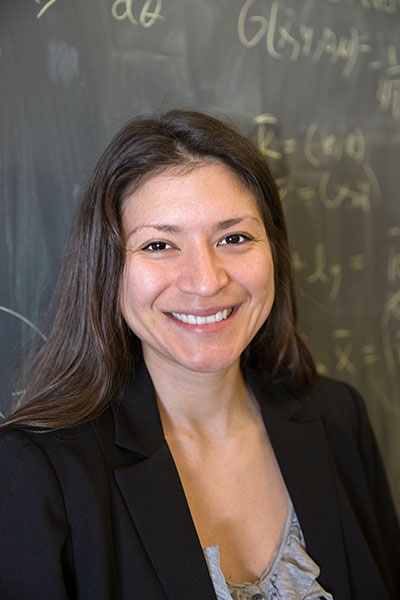
“(An underrepresented minority) undergrad told me, ‘I struggle so much and feel I’m going to fail, but then I see you walking around,'” says Marcella Gomez, assistant professor in UC Santa Cruz’s Department of Applied Mathematics and Statistics. (UC Santa Cruz photo by Carolyn Lagattuta)
“What the fellowship gave me was visibility. All we’re asking for is equal visibility,” says Marcella Gomez, a California Alliance postdoc fellow in engineering at Berkeley from 2015-17 who now is an assistant professor in the Department of Applied Mathematics and Statistics at UC Santa Cruz.
“The Alliance has a good number of supporters with influence and power,” she adds, “people who offer their mentorship and guidance, who want to help you succeed. And these are top universities. It’s such a statement to the world and the research community and to every university that these schools are taking the initiative to increase diversity.”
Gomez says she enjoys and takes seriously being a role model as an underrepresented minority professor in STEM, “especially for Mexican-American women who need to see me in this position to think they can do it, too.”
Making connections
The Alliance postdoctoral fellows are “trailblazers,” says Rodolfo Mendoza-Denton, a Berkeley psychology professor who is the Alliance’s lead researcher on the effects of discrimination and stigma on academic achievement.
And their path isn’t easy; he’s documenting and publishing research papers on the Alliance’s behalf about factors that impact these scholars’ attitudes, experiences and career plans.

“I just love the academic culture so much, the constant influx of fresh minds and ideas,” says Marcella Gomez, now on the UC Santa Cruz faculty. (UC Santa Cruz photo by Carolyn Lagattuta)
One trend Mendoza-Denton sees is that “the higher you go,” as a member of an underrepresented minority who’s climbing the ladder from undergraduate to graduate to postdoc to professor, there is significant fall-off of your peers on each rung, and “the less represented you are, the more isolated you can become.”
“For majority individuals,” adds El-Ghazaly, “finding a group to belong to can be easier, but often those groups exclude others. Given the stress of our academic work, not having a support network makes that work even more challenging.”
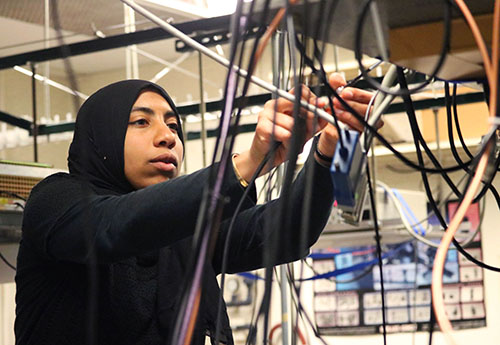
A tension develops in the academic/lab environment when professors don’t understand the experiences of underrepresented minority scholars, says postdoc Amal El-Ghazaly. (UC Berkeley photo by Kirpa Singh)
Mendoza-Denton says these cliques can affect a scholar’s ability to find colleagues to work with on research and its publication in scholarly journals.
In an April 2017 paper in the journal PLOS One, he and Alliance colleagues reported that underrepresented minorities publish research at significantly lower rates than non-underrepresented minority males, placing them at a significant disadvantage as they compete for postdoctoral and faculty positions.
“It’s common practice in STEM, but particularly in the higher ranks, for people to sit around, converse, and the next thing you know, they’re working on a paper together,” he says. “These are informal mechanisms through which professional advancement opportunities happen, and they disadvantage people on the outside looking in.”
The Alliance is examining a finding by Mendoza-Denton that Berkeley’s College of Chemistry doesn’t have such disparities by ethnicity and gender in its publication rates. The hypothesis, says Mendoza-Denton, is that the college’s highly structured program, with clear expectations for conducting and publishing research, doesn’t give one group an advantage over another.
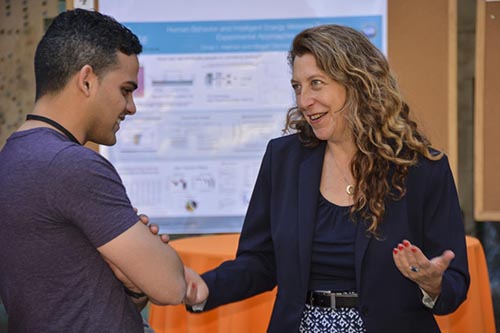
“I don’t know of any other postdocs who routinely have access to this kind of candid insider advice about advancing their careers,” says Colette Patt, Alliance director, greeting Alejandro Ruiz, currently a doctoral student in Berkeley’s physics department, at the 2015 California Alliance retreat at Caltech. (Caltech photo)
In addition to getting published, adds Mendoza-Denton, “it’s also important to feel like a valued individual, like you belong. It’s difficult when you look up and there are very few people, if any, who can understand what you’re going through. And that can affect your research, your product.”
“We’re trying to bring people together who share similar concerns and to keep them connected,” he says. “It’s important for individual scholars of color to see they’re not alone in this, that something’s been organized to counteract what they’ve experienced.”
El-Ghazaly says she looks forward to the Alliance’s annual retreats — the fifth retreat will be held at Berkeley at the end of the week — and was inspired by her experiences in the Alliance to start an informal Berkeley STEM Fam professional development group, as well as monthly themed dinners for underrepresented minority Ph.D. students and postdocs.
To attend the dinners, which also focus on mentoring and training, scholars are “coming out of the woodwork, my list keeps growing, and we typically fill the room,” she says. “It’s all about community and seeing the peers of color around me, peers of color who can support each other.”